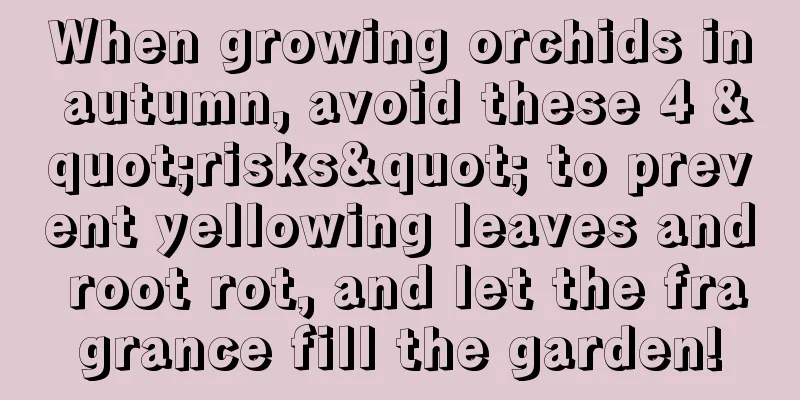When growing orchids in autumn, avoid these 4 "risks" to prevent yellowing leaves and root rot, and let the fragrance fill the garden!

The first risk: buying fake flowersEveryone may not be familiar with this, and many people directly exclaimed: Can you buy fake orchids? Yes! In fact, orchids are not just the ones we usually see. There are also many rare varieties of orchids. Some orchid lovers will buy some rarer and more expensive ones to cultivate. Once the price is high, it is inevitable that some unscrupulous merchants will take advantage of the situation and use fake expensive orchids to defraud people of their money. So if you have chosen a certain type of flower to grow and the price is relatively high, it is best to pay close attention and not be cheated. Second risk: pest riskCompared with other plants, the more precious the orchid is, the more delicate it is and the more susceptible it is to diseases and pests. No matter what variety of orchid it is, as long as you grow orchids, there will be problems with diseases and pests. In the future growth process, the more serious the diseases and pests are, the greater the degree of damage to the orchid and the higher the amount of loss will be. In order to effectively avoid diseases and pests, we must cultivate orchids scientifically and reasonably to prevent them from being invaded by insects. The third risk: the risk of decayIn the daily cultivation process of orchids, we must not only prevent orchid diseases and pests, but also prevent orchid root rot. Many friends feel that the air humidity is not enough in autumn, or they have not changed the habit of watering more in summer. Excessive watering of orchids causes the orchid's moisture to fail to evaporate and slowly accumulate in the potting soil, gradually causing the orchid's roots to rot. Although this phenomenon is often encountered, the problem is indeed difficult to deal with. It requires changing pots and soil, as well as pruning the roots, which is quite troublesome, so it is best for everyone to change their daily habits. The fourth risk: pesticide riskWhen orchids are infested with insects, many people will use pesticides to repel them. However, some friends do not do thorough homework and when spraying pesticides on orchids, they may spray too much, or spray in the wrong place, etc. Huahua would like to remind everyone that no matter what kind of pesticide you use on orchids, it is best to know the effects of the pesticide and the instructions for use. If you find that something is wrong, stop using it immediately. The above are the four risks that Huahua has summarized for everyone. I hope everyone can pay more attention to them in daily life, prevent their occurrence, and make your orchids bloom more beautifully! |
>>: How to tell when it's time to water your orchid
Recommend
Cultivation method of Dendrobium officinale
1. Maintenance methods 1. Temperature: between 20...
How to prune a fortune tree
1. Pruning time The best time to prune the money ...
How to prune and top bitter melon and pruning methods
Bitter melon pruning time Bitter melon can be pru...
Can silkworm litter be used as flower fertilizer?
Silkworm litter as flower fertilizer Silkworm lit...
How to prune tea trees
When to prune tea trees When is the best time to ...
What is the effect of using water-soluble fertilizer for cucumbers (formula and plan of water-soluble fertilizer for greenhouse cucumbers)
What is water soluble fertilizer There is actuall...
The meaning and Feng Shui symbolism of orchids
1. Meaning Since ancient times, orchids have been...
How to grow strawberries in pots
Soil selection When planting strawberries in pots...
The efficacy and function of Robinia
1. Cough relief Robinia has a good cough-relievin...
When is the best time to prune cloud bamboo?
The role of cloud bamboo pruning The branches and...
Cultivation methods and precautions of fortune tree
The money tree is a popular indoor plant that man...
How to prune a pear tree
When to prune pear trees The best time to prune p...
What to do with dried jasmine leaves
1. Insufficient light The iron jasmine itself lov...
What is the best way to grow roses in winter?
The beauty of roses is appreciated by countless p...
These 10 kinds of flowers and plants grow better in hydroponics, don’t be silly and only grow them in soil!
1. Asparagus fern 1. The branches and stems of as...









